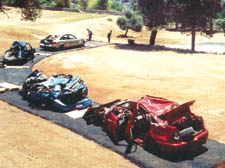|
|
 |
| |

Vera Tamari’s Going For A Ride |
Artists driven by an occupation
Suppression of Palestinian creativity has provoked generations of evocative work – including a traffic jam, writes Michael Mann
Palestinian Art From 1850 to the Present.
By Kamal Boullata.
Saqi Books £25.
AFTER Israeli troops blasted the Palestinian city of Ramallah in 2002, Palestinian artist Vera Tamari took a look at the devastation. Among the debris was the wreckage of her friend’s red Volkswagen Beetle car, crushed by a tank, and Tamari had a flash of inspiration.
For an exhibition mounted in reply to the assault she arranged a line of crushed cars on a strip of asphalt laid across a football field – wreckage on a road to nowhere, it was an absurd and poignant statement.
A crowd partied around it until midnight and when a pair of Israeli tanks arrived in the early hours they pulled up in astonishment.
The crews scratched their heads and left. But a week later a larger force arrived. It also paused, but instead of leaving drove over the installation until it was flattened.
Afterwards, they shelled it, then dismounted and urinated on what was left.
Tamari, who filmed the whole thing, quipped: “I’ve always been a great admirer of Duchamp,” referring to the French artist controversial for making an installation of a urinal.
“Brutal art critics, these soldiers,” comments artist Kamal Boullata in his outstanding study of Palestinian art.
The anecdote is one of many snapshots of a dehumanising occupation in which violence shapes art – or, in the case of Tamari’s cars, art shapes violence.
Forget groping for the meaning of a sheep in formaldehyde or an unmade bed, this is a glimpse at another world of depth and diversity that captures the zeitgeist of dispossession, the romance of nostalgia and thwarted passions. Palestinian art has been dismissed over here as primitive. Even in Semite tradition, which venerates oral history, artists have been the poor cousin of poets.
But it turns out generations of occupation and Israel’s attempts to erase Palestinian culture altogether had a special effect. Not all Palestinian artists have had access to their historical artistic narrative; the lives of artists in the West Bank and Gaza are very different to those in Israel proper or in the diaspora. The outcome is a blaze of different styles.
In a place where the Old Testament is justification for Israel’s occupation, perhaps only God knows what the tank crews would make of it all.
They might, however, reflect that Nazi chief Herman Goering enjoyed quoting a line from a Hanns Johst play: “When I hear the word ‘culture’ I reach for my gun.”
Art and culture have always been the enemy of totalitarian regimes.
But we can at least reflect that while the brush may not be mightier than the sword, these Palestinians have at least proved civilisation survives the worst of bombs, bulldozers and blockades. |
 |
|
 |
 |
|
 |
|


